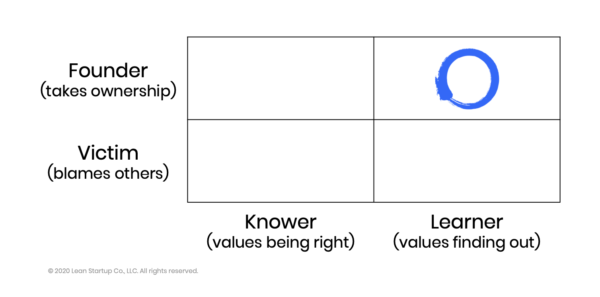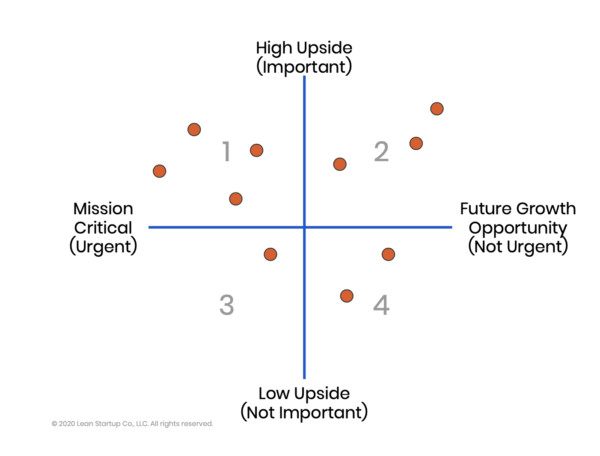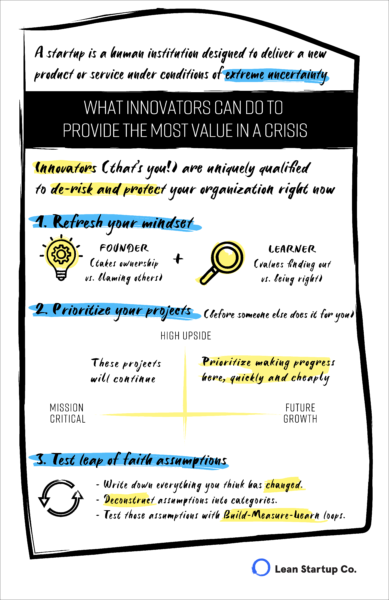Webinar: How Your Innovation Program Can Provide the Most Value in Times of Crisis

Long before today’s current, unprecedented state, Chris Stephens, Head of Education at Lean Startup Co., asked Eric Ries a simple question: Why does Lean Startup exist? And Eric told him that, in his view, humanity faces—and will continue to face—massive, seemingly insurmountable threats. But if we can teach enough people how to be effective innovators and leaders, then I think we can tackle those problems. Certainly, Ries’s vision is now more relevant than ever.
As innovators, you are probably in a role that deals with a lot of extreme uncertainty, especially now. Luckily, your skills and experience as innovators, entrepreneurs, and leaders make you uniquely qualified to tackle that uncertainty. The big shift to make that happen is going from the role of innovator as we traditionally think of it (creating new products and services) to innovation as de-risking, analyzing, and testing the underpinning assumptions of your organization or company.
In a recent webinar series, Chris Stephens and Ben Hafele walk through the things you can do right now to leverage those skills and provide the most possible value in your work.
Here’s what they suggest:
- Refresh your mindset

Given the ever-changing circumstances, it’s important to reground yourself in a Founder mindset. It’s easy in times like these to slip into a Victim’s mindset, blaming others instead of taking ownership of what is in your control.
Couple this sense of ownership with a Learner’s mindset (valuing figuring things out instead of being right) and you are now well-equipped to face today’s unique challenges. In a world of uncertainty, what is true will change from day to day, but a strong Founder/Learner mindset can handle those changes.
- Prioritize your projects (before someone else does it for you)
At least some form of reprioritization is happening at every company and organization around the world. Make sure those prioritizations are not just knee-jerk reactions that shut down all innovation or future opportunities. Neglecting all future growth work right now is a mistake. An Eisenhower Matrix is helpful here (we modified the axis labels a bit).

It makes sense to completely deprioritize quadrants three and four right now in order to focus on the essential core aspects of the business (quadrant one). However, quadrant two, where many innovators operate, may also face immediate shut down. But there are still ways to make progress on those important future growth opportunities. Testing those leap-of-faith assumptions (LOFAs) is one way to do this, and it’s a strong argument to take to leadership—behavior is going to change forever after this; we need to understand those chan
One thing you can do to make progress under quadrant two is to test your original LOFAs to make sure they are still valid (especially as these are the most disruptive if proven wrong). First, deconstruct the assumptions and assign them to categories. You can categorize assumptions into those about desirability (do your customers need your value prop?) , feasibility (can you build your value prop?), and viability (can you make money / impact?). Then, use Build-Measure-Learn (B-M-L) loops to de-risk those new assumptions.
Even though extensive, on-the-ground testing is currently impractical, right now data is quick and cheap. Customers want to talk right now—they want to give feedback and discuss the changing world.
Innovators were built to succeed in times of extreme uncertainty. With the right mindset and actions, you can add even more value than you already do.
Thanks to David Kallison for contributing this piece. If you seek to bring the entrepreneurial spirit to your organization, Lean Startup Co. can help.

